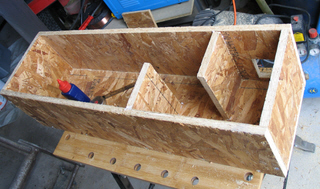
| Home page | Site history | Recent picture updates | Picture gallery | Camera details |
| Squirrels | Wildlife pictures | 2010 swallows' nest | Pictures captured by viewers | Sheffield weather |
My wife often heard little owls (Athene noctua), when they were standing on nearby lamp posts in the evening as she was putting her horse into its stable.
Early one afternoon during the autumn of 2004, I heard a noise coming from the chimney in our living room, but took little notice of it. When I next went into the living room, there was a little owl standing on the carpet. I picked it up; carried it outside, and let it go. It appeared that it had been looking for a suitable roosting site when it had fallen down the chimney.

To provide the owl with a suitable place to roost, I made a little-owl nest box to the design shown in Leaflet 32 issued by the Barn Owl Trust. (www.barnowltrust.org.uk/Forms/No_32.pdf.) The picture on the right shows the layout of the box before I had made the roof. The inner separators are to make the nesting area more secluded and to separate it from the potential roosting area of the second owl.
There was no suitable tree to mount the box on, so I decided to mount it on a pole. As there would be no protection from the sun, the box could have become very hot in summer, so I decided to give the box a "safari roof", i.e., similar to the roof of this name fitted to Land Rovers intended to be used in the tropics. For this I used thin plastic-covered metal sheet screwed onto the box, but spaced from it by a number of 18mm wooden spacers, as can be seen in the picture on the left. This allows air to flow between the metal and the box, so will reduce the maximum temperature reached during the heat of the day. The metal actually covers only the roof and the walls of the nesting area on the southern and eastern sides. The metal made it difficult to fasten the roof down, so I fitted hinges on one side and then held the roof down using a plastic cable tie. (This has since been replaced by 3mm fencing wire following the cable tie breaking in the January 2007 gales.)
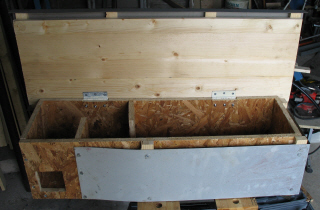
The picture on the left was taken before the "veranda" was fitted. The veranda was made from a square piece of timber, about 20cm across, fastened in front of the entrance hole by two strips of wood that were bolted to the floor of the box.
Before fastening the roof in place, I put about an inch of wood shavings (used by my wife for her horse's bedding) on the floor of the nesting area.
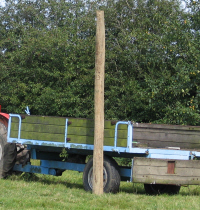
I mounted the box in an open space so that we could watch it from the kitchen window. I used a substantial pole, which I sank into the ground about 3 feet to ensure that the box did not move in strong winds, as the site is exposed to the prevailing westerly winds. The box is mounted on a steel plate, welded onto a piece of steel angle that I bolted onto the side of the pole near the top. The photograph to the right gives an impression of the height - I had to stand on the side board of the trailer to fit the box onto the pole.
Within 3 days of the box being put in place (15/8/04), we saw a little owl standing on the roof and a day or two later, one going inside. Two owls have roosted in the box ever since, which is quite fortunate as I understand that there are only about 2000 occupied little owl nesting sites in the UK, and we live in Yorkshire, which is quite close to the northern edge of the UK population of little owls. (Different sources place this somewhere between the Humber estuary and the Scottish border.) As the box is only about 30 metres from our house, we can see the owls at dusk and dawn as they generally stand on the "veranda" of the box for a few minutes before going in, or coming out. They seem to take no notice of us moving about in the kitchen, even when the lights are on. (Had I known this at the time I made the box, I would have sited it a lot closer to the house, which would have allowed me to fit an internal video camera.)
I fitted a webcam in an upstairs window of the house. The webcam is aimed at the box so, if you are lucky, you will be able to see one, or both, of the owls standing on the "veranda" near the entrance hole. They seem to stand near the entrance of the box much longer in the evening than in the morning. In the evening, they can stand on the box for more than an hour when the weather is warm. In the summer, they may spend a lot of time standing on the box during sunny days and, if you look during late May or early June 2005, you will probably see an owlet looking out of the box or standing on the "veranda".
I understood that the territories of little owls overlapped, so I made a second nestbox with the hope that one of the owlets from the box may take up residence. In August 2005, I saw one of the owlets taking a look at the second box, but one of the parent owls immediately flew over to it with its "talons bared", so I guess the parent's intention was clear. This suggests that, after about August, the owlets are forced to find their own territories, and this explains why we see only the original parent owls in the garden after this month.
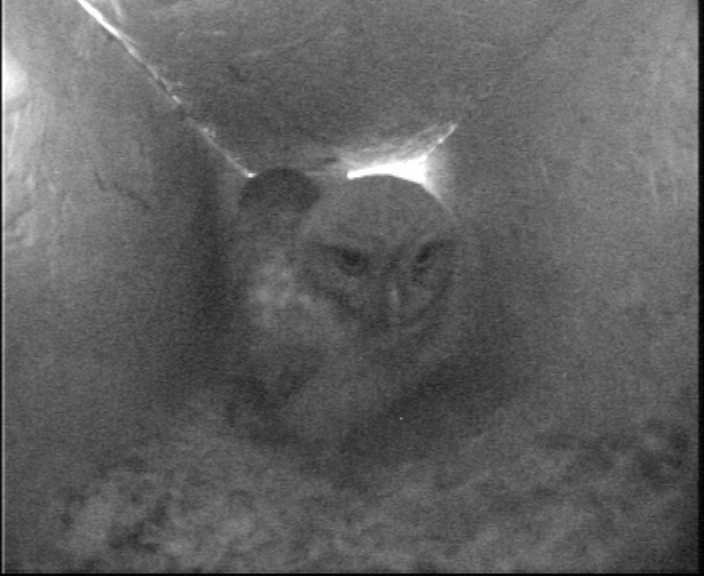 The parents seem to use the second box as a larder/feeding station when the young owls are fledging, and fly between the two boxes carrying food.
Possibly as a result of this, as soon as the young owls fledge, they make their way to the second box, and continue to roost there,
as can be seen in the photograph to the right, which shows two of the owlets standing inside the second box.
This photograph was taken on 17/6/06 at 11:40.
The parents seem to use the second box as a larder/feeding station when the young owls are fledging, and fly between the two boxes carrying food.
Possibly as a result of this, as soon as the young owls fledge, they make their way to the second box, and continue to roost there,
as can be seen in the photograph to the right, which shows two of the owlets standing inside the second box.
This photograph was taken on 17/6/06 at 11:40.
On 24/6/06, I found one of the young owls in our living room, it having come down the chimney. The young owl was quite calm and seemed to become very comfortable once I began to scratch its head, as can be seen on the photograph on the left, below.
The photograph in the centre, below, shows me about to stand the young owl on a fence post in order to release it.
We had often seen the owls lying down inside the nest box whilst looking out of the entrance hole, but had never seen any other species of bird do this. On 28/7/06, the camera caught the photograph on the right, below, which shows one of the owls lying on the veranda of the nest box. The owl had been standing on the veranda of the nest box for nearly 40 minutes before it decided to lie down. It remained recumbent for a further 18 minutes, but I can assure you that it then stood up and was perfectly OK.
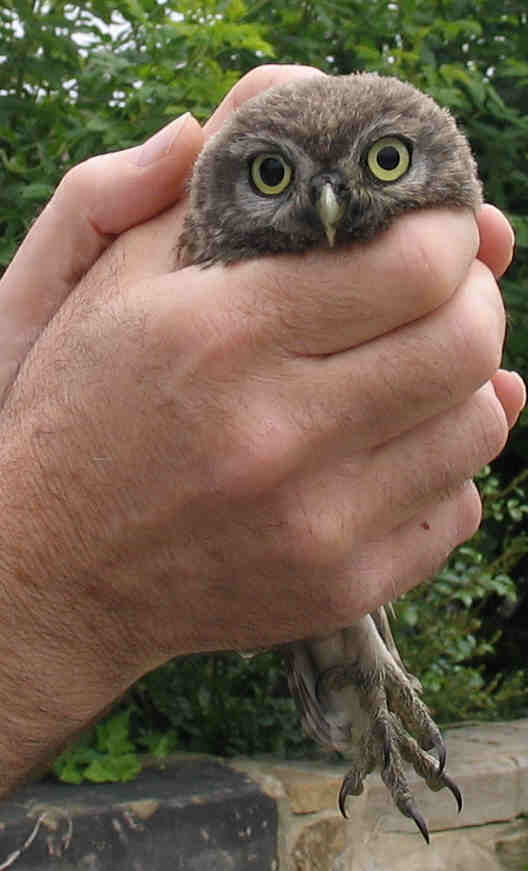 |
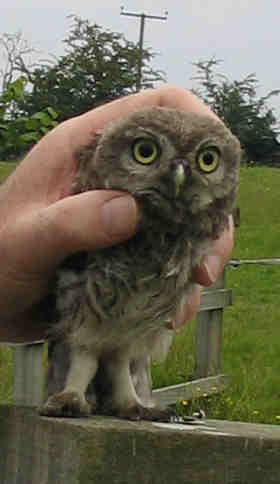 |
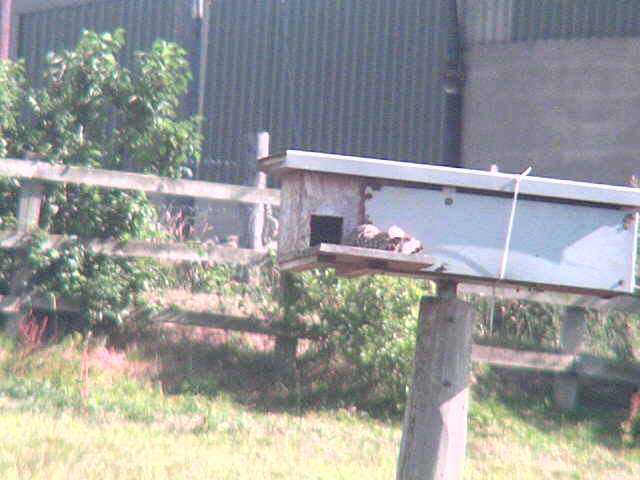 |
The table, below, shows the breeding success rate of the nest box. We are sure of the number of young that was reared in 2005 and 2006; however, in 2007, we think that there was a brood of 4 but, as the first owl to fledge kept returning to the nest box, we cannot be completely sure that there was not a brood of 3.
Year |
Number of Owls to fledge |
First fledged |
Second fledged |
Third fledged |
Fourth fledged |
Fifth fledged |
Sixth fledged |
2005 |
3 |
6/6/05 |
? |
17/6/05 |
- |
- |
- |
2006 |
4 |
8/6/06 |
? |
? |
? |
- |
- |
2007 |
4 (possibly only 3) |
4/6/07 |
8/6/07 |
15/6/07 |
? |
- |
- |
2008 |
4 |
1/6/08 |
1/6/08 |
1/6/08 |
9/6/08 |
- |
- |
2009 |
2 |
28/5/09 |
30/5/09 |
- |
- |
- |
- |
2010 |
6 |
13/6/10 |
16/6/10 |
17/6/10 |
17/6/10 |
? |
? |
2011 |
4 |
10/6/11 |
20/6/11 |
20/6/11 |
3/7/11 |
- |
- |
2012 |
2 |
6/6/12 |
6/6/12 |
- |
- |
- |
- |
2013 |
2 (possibly 3) |
? |
8/7/13 |
8/7/13 |
- |
- |
- |
2014 |
4 |
8/6/14 |
? |
? |
? |
- |
- |
2015 |
4 |
16/6/15 |
? |
? |
? |
- |
- |
2016 |
0 |
- |
- |
- |
- |
- |
- |
2017 |
0 |
- |
- |
- |
- |
- |
- |
2018 |
0 |
- |
- |
- |
- |
- |
- |
2019 |
5 |
9/6/19 |
12/6/19 |
13/6/19 |
13/6/19 |
14/6/19 |
- |
2020 |
5 |
1/6/20 |
3/6/20 |
9/6/20 |
10/6/20 |
12/6/20 |
- |
2021
|
2 |
8/6/21 |
10/6/21 |
- |
- |
- |
- |
You are visitor number 1035 to this page, which originally became live on 21/7/07 and was last updated: Thursday, 17 February, 2022 11:41